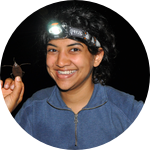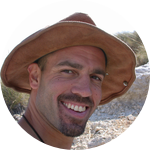About This Project
Snails and crabs occupy the land-water ecotone across Africa, but very little is known about them. These animals transmit parasites that infect people. This research aims to shed light on the behavioral ecology of these species to provide insight into their roles as intermediate hosts for disease. In January 2014, we will travel to South Africa to study the behavior of the crabs and snails in their natural habitat.Ask the Scientists
Join The DiscussionWhat is the context of this research?
Life in marshy habitats in South Africa
has both advantages and limitations. These nutrient-rich environments create a bounty for the organisms that live in them. However, warm waters also provide favorable conditions for the parasites that rely on an aquatic medium to complete their life cycle. Snails and crabs flourish at the land-water interface in Africa, and these invertebrates are often parasitized by trematode flatworms. Trematodes have a complex life cycle that involves several different host species including, a mollusc, a crustacean or fish, and, finally, a bird or a mammal.
The disease that is the focus of our current investigation is paragonimiasis, a lung disease that has symptoms similar to tuberculosis. It is estimated that over 20 million people are infected worldwide. Our project aims to understand the basis for paragonimiasis transmission. Over one hundred years ago, it was discovered that the trematode Paragonimus is the cause of the paragonimiasis lung disease. But the molluscan host of Paragonimus—and the mechanism of transmission between the mollusc and crab—remains unknown in Africa.
What is the significance of this project?
Paragonimiasis occurs primarily in western and central Africa, and it is acquired through the consumption of raw or undercooked crabs. The low incidence of the disease in South Africa could be a result of cultural practices (not eating raw meat), misdiagnosis (confusion of paragonimiasis with tuberculosis), or climate (it is a more temperate region). Trematode parasites respond positively to higher temperatures, and this could increase the infection rate in southern Africa as the climate warms. Our research will help to identify human populations in southern Africa at risk for this disease.
Several mammal species in addition to humans are affected by paragonimiasis, including mongooses and otters. These animals also acquire the disease through consumption of crabs. Although paragonimiasis was discovered in otters and mongooses over a century ago, the transmission cycle of the parasite remains mysterious. It is essential that we study the invertebrates that serve as intermediate hosts of the parasite in order to understand the mechanics of disease transmission. Our research in southern Africa under controlled conditions will shed light on the etiology of paragonimiasis in the tropics where incidence rates are much higher.
What are the goals of the project?
We are studying the ecology of African molluscs and crabs, as well as the infection rates of Paragonimus in the tissue of these hosts, to better understand the basis for the propagation of paragonimiasis in Africa today.
We will collect crabs and snails in several locations in South Africa, and we will study the behavior of the crabs in their natural habitat using underwater video, in an attempt to discover how the crabs are infected by Paragonimus cercaria (the larval parasites that are shed by the molluscan host). Dissections of crabs and snails will take place in the field, and the tissues of infected individuals will be taken to museum laboratories for comparative study and long-term preservation.
You will be kept up-to-date on our expedition with exciting imagery from the field in South Africa and with Twitter updates (@potamon_crab). If you have any questions about our work, feel free to contact us!
Budget
Funds will be used to obtain the equipment necessary for fieldwork and to cover the cost of travel and lodging. A rugged field dissection kit and microscope will be used to identify parasites in host tissue and to isolate them for study in the lab. You can take a look at the field microscope we will be using by clicking here.
An underwater camera (GoPro 3+) will be used to track the behavior of crabs in their natural habitat. Click here to see the camera.
Field sites will be visited via rental car, and city to city travel between museums will be via short plane flights.
Endorsed by
Meet the Team
Team Bio
I am a graduating senior, and I work in Dr. Alan Shabel's lab in the Integrative Biology Department. Dr. Shabel's research focuses on the ecology of the land-water ecotone in Africa. I am interested in the dynamics of disease transmission within this same system. Parasite-host relationships are fascinating, but poorly understood, in the context of whole ecosystems. My hope is to determine how parasitic trematodes and hosts interact. By shedding light on the evolution of the parasitic life cycle, we can better predict how these systems will evolve in a changing climate and environment.Neetha Iyer
My interest in the sciences began at a very early age, and I have spent my life trying to feed my curiosity for the natural world. It's possible these interests stem from the fact that I spent my childhood growing up in Dubai, a city rather devoid of a thriving natural environment. Childhood visits to India served as a constant reminder of the richness and diversity of life and so naturally I began to crave a deeper understanding of how biological systems are sustained.
As a student in the department of Environmental Science, Policy and Management (ESPM) at UC Berkeley, I have gained an appreciation for the intricate relationships that exist between humans and the environment. I hope to study these interactions in the context of disease transmission between animals in tropical ecosystems and I plan to pursue a doctoral degree in parasite ecology. I am interested in the evolutionary history of trematode parasites and their hosts which will provide insight into the spread of disease with global climate change.
Alan Shabel
I work at the intersection of ecology, paleontology, and anthropology. My current research is focused on the mammals that forage for crabs and snails at the African land-water ecotone. I study the biogeochemistry of this food web and the ecomorphology of the predators in relation to their hard-shelled prey. In addition to this research, I teach courses in general biology, mammalogy, and field biology at U.C. Berkeley, and I lead conservation and restoration projects in the San Francisco Bay Area.
Project Backers
- 19Backers
- 105%Funded
- $3,675Total Donations
- $193.42Average Donation


